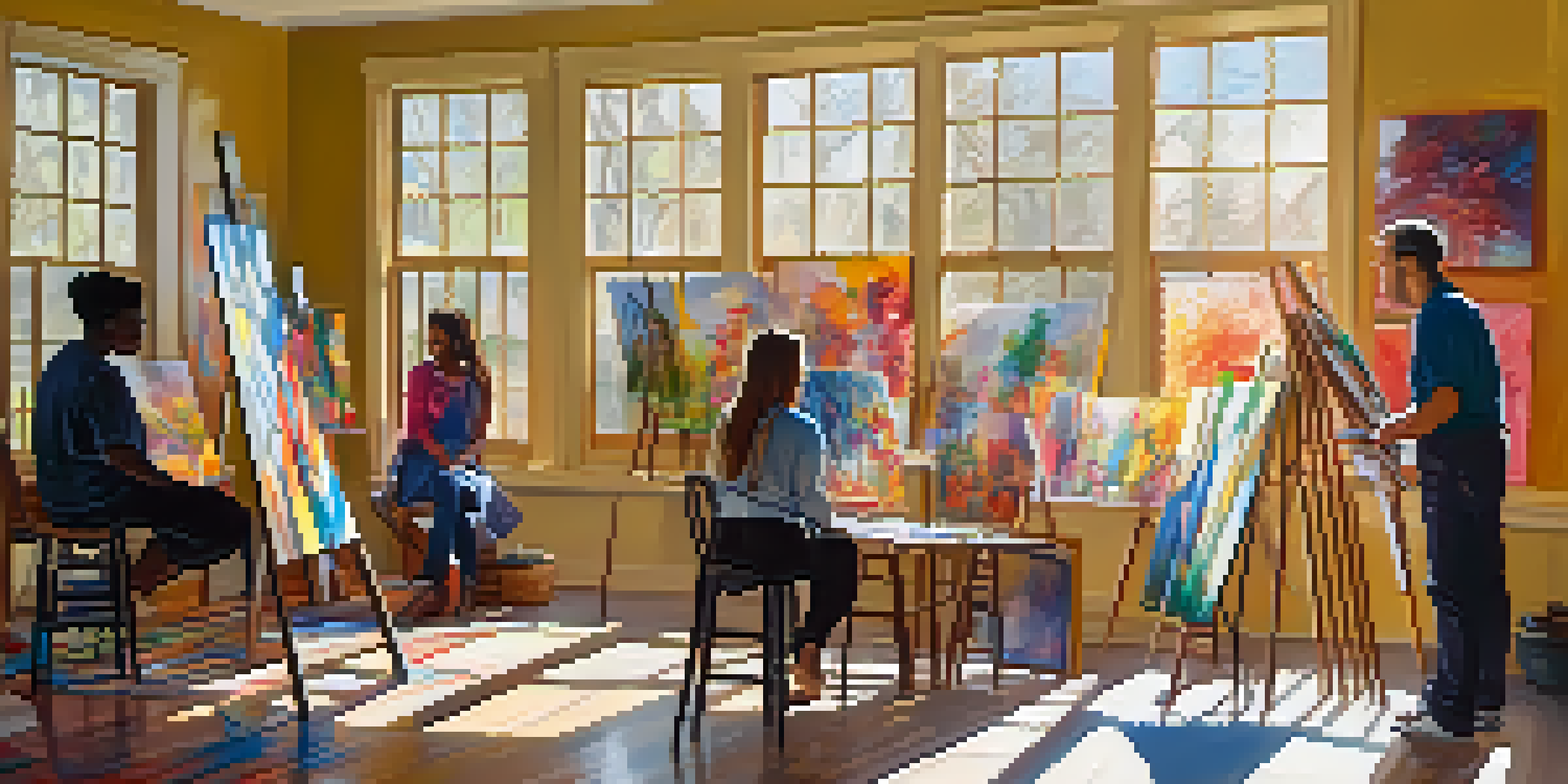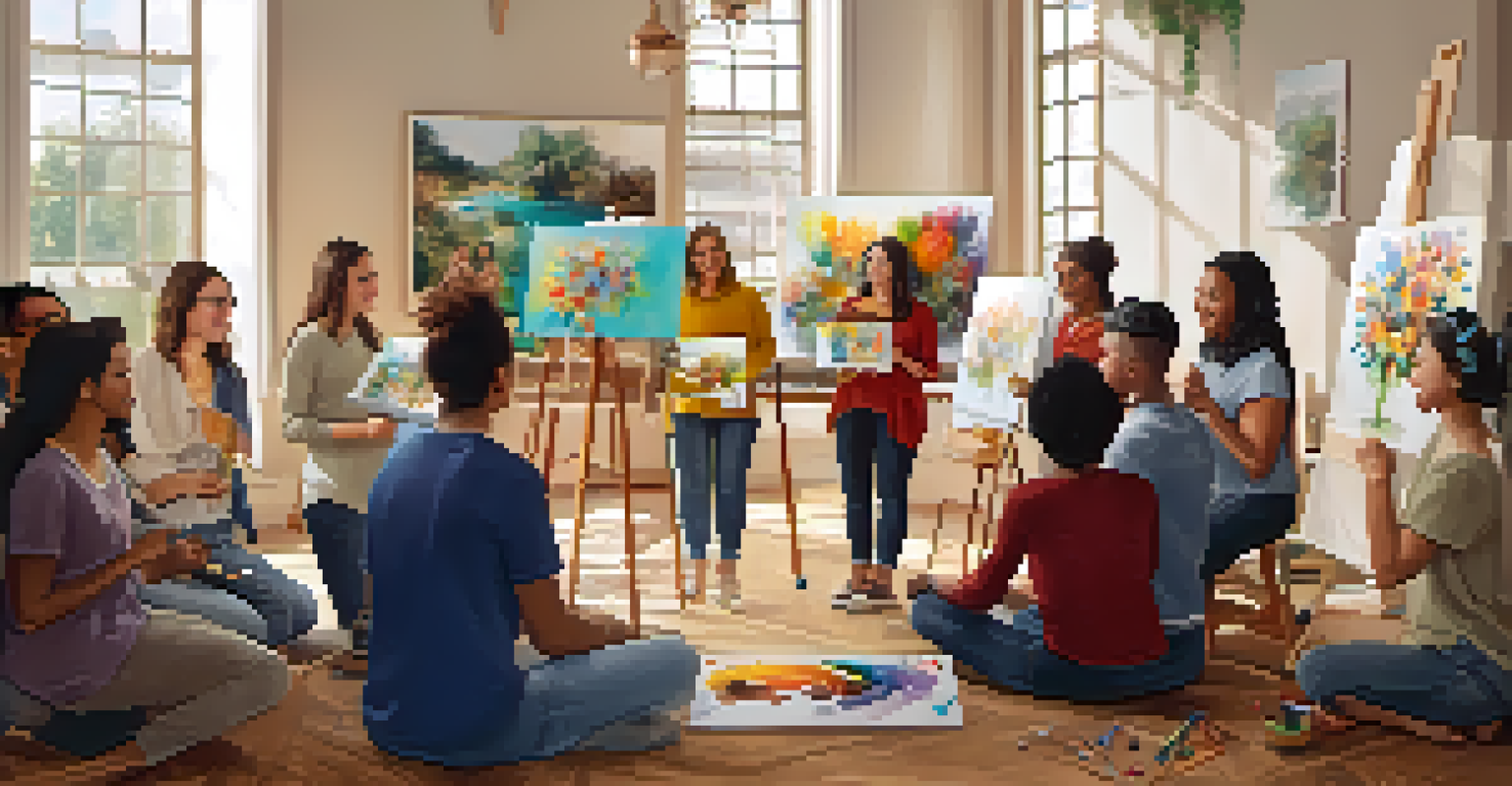The Benefits of Painting for Trauma Survivors in Art Therapy

Understanding Art Therapy and Its Role in Healing
Art therapy is a therapeutic practice that uses creative processes to facilitate emotional healing. For trauma survivors, it provides a safe space to express feelings that may be difficult to articulate. Through mediums like painting, individuals can explore their emotions in a non-verbal way, allowing for deeper self-reflection and understanding.
Art can be a powerful means of communication that transcends words.
In this context, painting serves as a bridge between the subconscious and conscious mind. It helps survivors externalize their trauma, making it tangible and manageable. Art therapy isn’t just about creating beautiful artworks; it’s about the journey and the healing that occurs along the way.
By engaging in art therapy, trauma survivors often discover new perspectives on their experiences. This creative outlet fosters resilience, helping them to reclaim their narratives and find empowerment in their healing journey.
The Therapeutic Benefits of Painting
Painting offers numerous therapeutic benefits, especially for those who have experienced trauma. One of the most significant advantages is the ability to express complex emotions safely. For many, putting brush to canvas allows feelings of anger, sadness, or fear to flow out, which can be incredibly cathartic.

Moreover, creating art can promote mindfulness, encouraging individuals to focus on the present moment. This practice can reduce anxiety and stress, as it often requires concentration and can be meditative. The repetitive motions of painting can also serve as a grounding technique, helping individuals feel more centered.
Art Therapy Aids Emotional Healing
Art therapy provides trauma survivors a creative outlet to express and process complex emotions, facilitating their healing journey.
Additionally, the act of creating something visual can boost self-esteem and provide a sense of accomplishment. For trauma survivors, reclaiming control over their environment and expressing their creativity can be a powerful step toward healing.
Building Connections Through Shared Experiences
Art therapy often involves group settings where trauma survivors can connect with others who share similar experiences. This sense of community can be incredibly healing, as participants realize they are not alone in their struggles. Sharing artwork and discussing personal journeys fosters empathy and understanding among group members.
Creativity takes courage.
Painting together can create a supportive environment where stories and emotions are shared openly. This connection helps reduce feelings of isolation, which is common among trauma survivors. The bonds formed in these settings can provide a lasting support network even beyond therapy sessions.
Furthermore, witnessing others' journeys through their art can inspire participants to explore their own feelings more deeply. This shared process of creation and reflection can pave the way for collective healing and growth.
Exploring Emotions Through Color and Form
In painting, colors and forms can carry deep emotional significance. For trauma survivors, choosing specific colors may reflect their inner emotional state, providing insights into their feelings. For instance, darker hues might signify pain or sadness, while vibrant colors could represent hope or joy.
The act of selecting colors can be a therapeutic exercise in itself, encouraging individuals to reflect on their emotional landscape. This exploration can lead to greater self-awareness and understanding of their trauma. By visually representing their emotions, survivors can begin to process and work through them.
Painting Boosts Coping Skills
Engaging in painting enhances coping mechanisms for trauma survivors, fostering resilience and providing a constructive way to manage stress.
Moreover, the freedom of expression that painting offers allows individuals to explore complex feelings that may be difficult to discuss verbally. This visual language can often communicate what words cannot, helping to bridge the gap between trauma and healing.
Developing Coping Skills Through Artistic Expression
Engaging in painting as a form of art therapy can significantly enhance coping skills for trauma survivors. As they learn to express feelings through art, they also develop healthier ways to manage stress and emotional upheaval. This creative outlet becomes a vital tool in their personal coping toolbox.
Painting encourages problem-solving and critical thinking, as survivors may experiment with different techniques and styles. This process fosters resilience and adaptability, both of which are essential for navigating life's challenges. The skills gained through art therapy can transcend the canvas, influencing other areas of their lives.
Additionally, the focus required in painting can provide a welcome distraction from negative thoughts. This redirection of attention can help individuals manage anxiety and depressive symptoms, promoting a sense of calm and control.
Encouraging Self-Discovery and Personal Growth
Art therapy through painting can be a profound journey of self-discovery for trauma survivors. As individuals create, they often uncover hidden emotions and memories that may have been buried. This process can lead to significant personal insights and breakthroughs in understanding their experiences.
Moreover, painting allows survivors to explore their identities in a safe and nurturing environment. By expressing themselves creatively, they can experiment with different aspects of their personality and beliefs. This exploration fosters a sense of empowerment and agency over their healing process.
Art Creates Lasting Legacies
The artworks produced in art therapy serve as powerful legacies, encapsulating survivors' journeys and inspiring dialogue about trauma and recovery.
The growth experienced through this artistic journey can be transformative, enabling survivors to see themselves in a new light. As they embrace their creativity, they often find renewed hope and motivation to continue on their path of recovery.
Creating a Lasting Legacy Through Art
One of the beautiful aspects of painting in art therapy is the creation of tangible legacies. The artworks produced can serve as lasting reminders of a survivor's journey, encapsulating their struggles and triumphs. These pieces become symbols of resilience and strength, which can be shared with others or kept as personal mementos.
Many trauma survivors find comfort in knowing that their stories are expressed and preserved through their art. This legacy can provide a sense of continuity and hope, reminding them of how far they've come in their healing journey. Moreover, their art can inspire others who may be facing similar challenges.

Creating a legacy through painting not only honors the survivor's experiences but also opens doors for dialogue about trauma and healing. By sharing their art, individuals can advocate for awareness and understanding, contributing to a larger conversation about mental health and recovery.